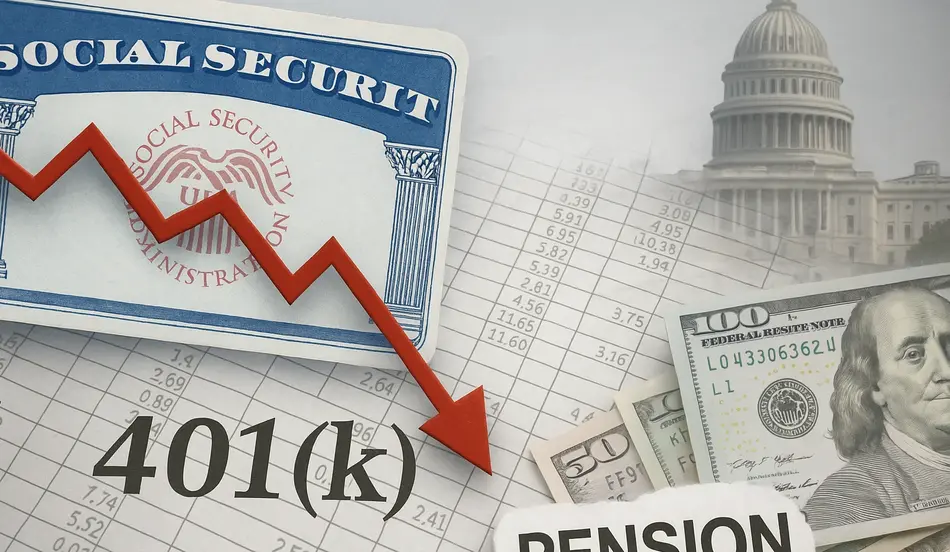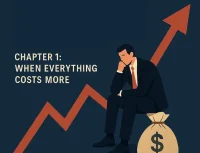The future of retirement security in the United States faces mounting strain. The Congressional Budget Office (CBO) projects that the Social Security trust fund will run short by 2033, leaving retirees facing an automatic 20% benefit cut unless Congress intervenes.
At the same time, the U.S. retirement system earned a C+ rating in the 2024 Mercer CFA Institute Global Pension Index — lagging behind top-ranked countries like the Netherlands and Denmark, and only slightly above middle-tier peers.
The U.S. continues to rely on a patchwork system of Social Security and voluntary 401(k) plans. Analysts warn that without reforms, millions of Americans could enter retirement without sufficient savings.
Table of Contents
A System at Risk
Social Security is the foundation of retirement income for nearly 67 million Americans. But the program, designed in the 1930s when life expectancy was much lower, is showing cracks. Today, Americans are living longer while birth rates have declined, shrinking the ratio of workers to retirees.
By 2033, the program’s reserves will be depleted, and payroll tax revenue will only cover about 80% of promised benefits.
“This isn’t a cliff, but it’s a sharp cut,” said one policy analyst. “If Congress does nothing, retirees could suddenly face a one-fifth reduction in income — devastating for lower-income seniors who rely on Social Security as their primary source of support.”
A Strong Workforce Secures the Future
As Social Security faces pressure from fewer workers supporting more retirees, every new hire matters. Post your job on WhatJobs and help build a sustainable workforce.
Post a Job Now →401(k) Plans: A Leaky Bucket
Beyond Social Security, many Americans rely on 401(k) plans, introduced in the early 1980s as an alternative to traditional pensions. These accounts allow workers to defer part of their salary into investments, often with employer matches.
Yet the system has major flaws:
- Participation remains uneven. In 2023, 70% of U.S. workers had access to a retirement plan, but only 53% participated.
- Savings are unevenly distributed. The median retirement savings for Baby Boomers is close to zero, while averages are skewed by high earners with millions invested.
- Leakage drains accounts. Early withdrawals for emergencies cost workers between $60 billion and $105 billion in 2019 alone.
“Imagine filling a bucket with water, only to drill holes in the bottom,” said one economist. “That’s essentially how the U.S. retirement system works when people cash out savings every time they change jobs.”
International Comparisons: How Others Do It
Countries that earned “A” grades in the Mercer Index share common traits: mandatory savings, broad participation, and stable income streams.
- The Netherlands requires employers and workers to contribute to collective pension funds. Opting out is not allowed, ensuring nearly universal coverage.
- Australia mandates employer contributions that have gradually increased over time. Today, almost every worker contributes, creating one of the world’s largest national savings pools.
- Chile pioneered privatized savings accounts, though reforms were later required to address inequality and insufficient contributions.
These models produce replacement rates of 65% or more — meaning retirees can expect at least two-thirds of their working income in retirement. By contrast, many Americans fall short of even 40–50%.
What’s Dragging Down the U.S.
Mercer penalizes the U.S. system for several reasons:
- Voluntary participation rather than mandatory savings.
- No annuity requirement, leaving retirees with lump sums to manage.
- Pre-retirement withdrawals and loans, which erode savings.
Supporters counter that Americans, on average, save more than twice the OECD median, and that U.S. retirees often report higher incomes than peers in countries like Norway or Denmark.
Still, averages mask troubling disparities: only 5% of Baby Boomers have saved enough to retire comfortably. Women, who tend to outlive men, are at particular risk of outliving lump-sum savings.
Congressional Reform Proposals
Lawmakers face a narrowing window to address retirement shortfalls. Several ideas are under discussion in Washington:
- Raising the retirement age. Some proposals suggest gradually increasing the Social Security eligibility age to reflect longer life expectancy. Critics argue this would disproportionately harm lower-income workers in physically demanding jobs.
- Increasing payroll taxes. Raising or eliminating the wage cap on Social Security taxes would boost revenue but faces political opposition.
- Expanding auto-enrollment. Recent bipartisan legislation encourages employers to automatically enroll workers into 401(k) plans, increasing participation rates.
- Encouraging annuities. Proposals would make it easier for 401(k) participants to convert savings into lifetime income streams, protecting against outliving assets.
Thus far, Congress has taken incremental steps, such as the SECURE Act 2.0, which expanded retirement account options. But experts say bigger changes are needed.
Strong Policies Start With Strong Workforces
While Congress debates Social Security reforms, businesses can act now. Post your job on WhatJobs and attract the workers who will drive growth—and help secure the retirement system’s future.
Post a Job Now →Generational Divide: Why Millennials and Gen Z Face More Risk
For Baby Boomers, Social Security remains a reliable backstop. But younger generations may face a far less secure future:
- Student debt delays saving. Many Millennials enter the workforce burdened by loans, pushing retirement saving further down their priority list.
- Gig economy workers often lack access. Freelancers, gig workers, and part-time employees rarely receive retirement benefits from employers.
- Job-hopping fuels leakage. Younger workers switch jobs frequently, and many cash out small balances instead of rolling them over.
- AI and automation may disrupt careers. With entry-level white-collar jobs at risk from artificial intelligence, stable long-term savings patterns could be harder to maintain.
“Gen Z will need to save earlier and more consistently than any generation before them,” one retirement planner said. “But the system isn’t designed to make that easy.”
Why Women Face Steeper Risks
Gender gaps compound retirement insecurity. Women live longer on average, often work fewer years due to caregiving responsibilities, and earn less over their careers.
Couples who withdraw lump sums often overspend, leaving widows particularly vulnerable. “Protecting retirement income is, in many ways, about protecting women,” one expert explained.
A Global Shortfall Looming
By 2050, experts estimate the world could face a $400 trillion shortfall in retirement savings. The U.S., with its voluntary and fragmented system, accounts for a major portion of that gap.
Nobel Prize–winning economists warn that managing a lump sum across decades — while accounting for health costs, market swings, and lifespan uncertainty — is “the nastiest problem in finance.”
The Road Ahead
Despite warnings, analysts say the U.S. system still has strengths: a culture of private savings, large retirement asset pools, and a progressive Social Security formula that benefits lower earners.
But coverage remains the weak link. “If the U.S. could get every worker into a plan and keep them from cashing out early, its grade would rise dramatically,” one pension consultant noted.
With Social Security’s deadline approaching, pressure is building on lawmakers to act. Whether the U.S. chooses mandatory contributions, higher taxes, or greater reliance on private markets, the choices made in the next decade will determine whether future retirees live with security — or uncertainty.
FAQs
1. Why is Social Security projected to run short by 2033?
Because fewer workers are paying into the system while Americans are living longer and collecting benefits for more years. Without changes, payroll taxes will only cover about 80% of promised payments.
2. Why did the U.S. earn a C+ in the global pension index?
The rating reflects gaps in participation, voluntary 401(k) savings, pre-retirement withdrawals, and lack of guaranteed income streams compared with top-rated systems.
3. What risks do younger generations face?
Millennials and Gen Z struggle with student debt, gig economy jobs, frequent job changes, and the looming impact of AI on careers — all of which make consistent saving more difficult.
4. What reforms could improve the U.S. system?
Experts recommend auto-enrollment in retirement plans, mandatory contributions, limiting early withdrawals, and promoting annuities to ensure lifetime income.




